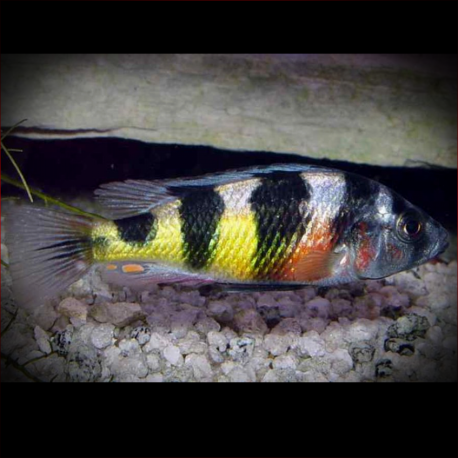More info
Datasheet
| Minimum Tank Size | 225 litres / 59.44 US gallons |
| Maximum Size | 12.7cm / 5.00inches |
| Temperament | Semi-aggressive |
| Care Description | Easy |
| Temperature | 24.4°C / 75.92°F - 27.8°C / 82.04°F |
| Carbonate Hardness | 10-15 |
| pH | 7.8-8.6 |
General DescriptionThe Zebra Obliquidens Cichlid, scientifically known as Haplochromis latifasciata, is a species native to Lake Kyoga and Lake Newampasa in Uganda, Africa. Often confused with Astatotilapia latifasciata, this fish is characterized by five distinct black bars on its body, with the color between the bars ranging from silver to greenish-gold. Mature males of this species develop a red belly, while females share a similar appearance but with a more silver coloration and the absence of the red coloration.
Aquarium SetupTo house Zebra Obliquidens Cichlids, a spacious aquarium with ample caves and hiding spots is recommended. Caves can be created from limestone, inert rocks, or African Driftwood. It is advised to use an aragonite-based substrate to maintain the required high pH and alkalinity level. Additionally, providing large flat rocks for spawning pairs and appropriate fry-feeding options like brine shrimp, daphnia, or crushed flake food is crucial.
BehaviourZebra Obliquidens Cichlids are classified as semi-aggressive fish and should be monitored closely if kept with other tank mates. They are known to be territorial, especially during breeding periods, and tend to establish their areas within the aquarium. Their behavior can become more aggressive when defending their fry or guarding their breeding territories.
Feeding and DietAs omnivores, Zebra Obliquidens Cichlids should be offered a diverse diet to ensure their nutritional needs are met. Their diet may consist of bloodworms, brine and mysis shrimp, spirulina, as well as specially formulated cichlid flakes and pellets. Providing a variety of food items helps promote their overall health and vitality in a captive environment.
Reproduction & DimorphismThe Zebra Obliquidens Cichlid follows the mouthbrooding reproductive strategy typical of many African Cichlids. Breeding pairs will typically lay eggs on flat rocks within the aquarium, with the female incubating the fertilized eggs in her mouth until they hatch. Once the fry are released, they can be fed on appropriate foods as they grow. During this period, the mother will actively protect the fry until they are self-sufficient.
Habitat and DistributionThese cichlids are native to the waters of Lake Kyoga and Lake Newampasa in Uganda, Africa. In the wild, they inhabit areas with varying water parameters and are commonly found in regions with rocky substrates where they can seek shelter and establish territories. The distribution of Zebra Obliquidens Cichlids is primarily limited to the freshwater bodies within their native range.

